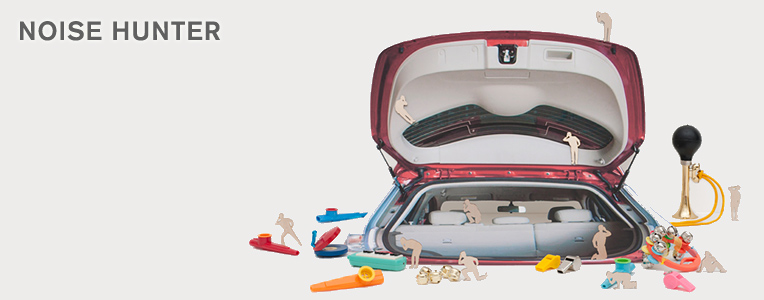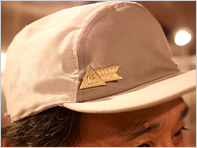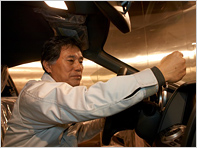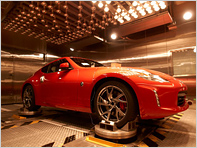Noise Hunter

On the trail of a boar or a deer, weapon in hand the hunter stalks his prey. But there is another kind of hunter...
The researcher on the track of rare flora in the furthest corners of the world. Intergalactic explorers chasing new planets in the depths of space. There are many types of hunters, each with their own targets and tools.
Nissan's huntsman is Akihisa Sonobe but he isn't pursuing wild animals or buried treasure. He's scouring for those small strange sounds you sometimes hear when driving-and he is relentless in his search for their source. We might call him a "noise hunter." In Nissan, though, they call him a "Takumi."

The Nissan Takumi wear badges on their caps like a medal for their rank.
The hunt for quality
"Takumi," which translates roughly as "master," is the top qualification title given to Nissan employees. These elite engineers are specialists possessing knowledge and skills in a particular area.
At the carmaker's Tochigi plant there are Takumi for each process: Takumi of Paint, Takumi of Body, and so on. As Takumi of Squeak and Rattle (Takumi of S&R), it's Akihisa Sonobe's job to work out the causes for tiny "squeak and rattle" sounds and then find solutions for removing them: You know, like the little odd noise the gear stick or side mirror makes that sounds a bit cheap or grating.
There are many causes for this infinitesimal hubbub. A join between plastic parts. The rubber in the suspension. A car might have as many as thirty thousand parts and just a micro slip in the planning or assembly can lead to these niggling noises. And this is why the manufacturer needs to pull out all the stops to ensure they tackle any aural irregularities that might irk the driver. Nissan takes even the smallest of sounds very seriously and has set a "zero noise" target for its vehicles no matter how long they are used by drivers.
But to do this requires a very special auditory sense, a refined ear that can attune to all the various sounds inside a vehicle. All day, every day, this hunter uses his internal microphone to search for his quarry.
Not just detection, though, a Takumi's job also involves implementing measures to improve a vehicle. If the hunter realizes that the cause of a sound is adhesive agent coming off due to heat, then a different adhesive needs to be found, or even the materials of the parts changed. This hunter doesn't just hunt-he fixes too.

Akihisa Sonobe uses a special version of rock-paper-scissors as part of his tactics for hunting the sources of noises.
The secrets of the Takumi's art
For a Takumi like Akihisa Sonobe, the ability to differentiate between a spectrum of sounds is utterly indispensable. And being able accurately to distinguish only certain sounds that arise when the car is moving is a real feat. "We identify only the squeak and rattle from all the sounds you can hear when the car is moving," he says. "If there are any odd sounds we soon realize." This hunter doesn't need a bow, not even a spear. His "weapon" is his ear that can filter through a wall of noise and extract only the "squeak and rattle" noises.
One of the requirements of the job, though, is speed. "There is no point if it takes time," he remarks. So what does Sonobe use the most to achieve the instantaneous response he wants- Sensibility: His sense of hearing that can make out sounds and the analytical prowess accrued through years of experience.
But there's one more tool in addition to the ear. Sonobe also utilizes another part of the body-his hand. To track the sounds in the car and determine the causes of the faintest of noises he uses his hand to touch, or at times to knock the parts inside the vehicle. "But there's a special way to knock," he tells us. He calls this tactic rock-paper-scissors. "Rock" is knocking with a closed fist; "paper" is tapping with your middle finger; "scissors" is pressing with the ball of a finger or palm of the hand. Just a minor tweak of the finger and the Takumi can detect the tiny noises, and as necessary figure out solutions. This all demands a rich understanding of how a car is constructed in order to track the sources of sounds and formulate a response.
Recently the team has also installed a special "environment-responsive vibration bench" machine that can recreate road conditions from all over the globe, meaning the work of the Takumi can accelerate even more. In Europe a car might drive one moment over cobblestones in an old town and another on a smooth German Autobahn. As the vibrations from the tires change, so too do the factors that affect squeak and rattle.
The machine is also able to recreate temperature conditions, such as a high 42°C (108°F), where solar insolation can reach 115°C (239°F), as well as environments that are extremely cold. Whatever the conditions, Nissan designs and tests its vehicles to aspire to the "zero noise" target.
Sonobe is very satisfied with his new "weapon." "We have become able to implement things more rapidly while moving the car in an environment the same as when actually driving."
The reputation of the Takumi is no secret within Nissan and they often get SOS calls from other departments. "There's this jarring noise that I'd like you to take a look at," say the people who come to see the hunter and get his advice. Sonobe has even had a nickname for the past ten years: Mr. Squeak and Rattle.
As technology has evolved, our cars today have much better cabin sound insulation. The unfortunate corollary of this, though, is that tiny "squeak and rattle" noises now stick out more. Fixing them is not an attention to detail just for its own sake; it makes a vital contribution to overall vehicle quality. To this end, the Takumi require unique talents that transcend regular human sensibilities and abilities. Or, as Sonobe calls it, "Tapping with your hand and sensing with your ear."

Inside the "environment vibration machine," which can instantaneously recreate the conditions of different road surfaces around the world.

